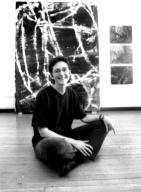Fulbright Program sends Margie Livingston to Germany
Queen Anne resident to create new works based on her research of German Romantic painters
Copyright © 2001 Queen Anne/Magnolia News, Published July 11, 2001.

Photo by Bradley Enghaus.
Click to enlarge.
Queen Anne artist Margie Livingston sits in her Seattle studio in front of her painting, "Untitled (thin over thick)," 2000, oil on canvas, 96 inches by 72 inches. Livingston's work investigates the interaction between abstraction and representation.
|
By Nancy Worssam
"Most artists today infuse their paintings with the subjective, the interior self. Everything's fair game and the German Romantics started it," says Queen Anne artist Margie Livingston.
In September, Livingston will embark on nine months of study in the place where the artistic experimentation with the subjective began -- Germany -- under the aegis of the J. William Fulbright Foreign Scholarship Board.
She will scrutinize original 19th century drawings and paintings by the leading German Romantic painter, Caspar David Friedrich, and develop a new body of work based on her research.
As Friedrich did, Livingston explores the interplay between abstraction and representation in her canvases, some of which are as large as 8 feet by 6 feet. She sees a strong affiliation between her work and that of Friedrich and other visual artists of the German Romantic movement.
In Mannheim and Berlin, Livingston will have access to Friedrich's sketchbooks.
"Studying these drawings will be the closest I can ever come to watching him actually work," she said. "The sketchbooks rarely leave the libraries in which they are archived, and having access to them is terribly exciting to me."
After examining the Friedrich works, Livingston will visit the forest region near the Baltic Coast where Friedrich lived. There she will create her own sketches from which she will develop a series of paintings.
The Romantic Movement began in the late eighteenth century. Breaking away from the formal classical style of the preceding 200 years, the Romantic poets and artists sought to appeal to the emotions rather than just the intellect.
They extolled the joys and sorrows of common folks, as well as the beauty and majesty of nature, and wanted their audiences to have a profound personal reaction to their work.
Caspar David Friedrich, the quintessential German Romantic painter, explored and glorified the natural world. His landscape paintings raise the prosaic to the poetic, bonding nature with spirit.
In the foreground of his massive paintings, one sees a tiny human figure facing into the landscape, forcing the viewer to enter it too. It is impossible to look at these works without being drawn into the canvas.
Friedrich invites his audiences to step into the natural world he has created and be regenerated by all that it has to offer. His paintings, in effect, provide a link between human being and nature, between temporal and eternal.
The Fulbright award will allow Livingston to prove her own connections to Friedrich. She is especially fascinated by his paintings of trees -- they're real trees but seem transformed into something more mystical. Livingston sees in them the antecedents of her own tangled linear imagery.
She notes that Friedrich was one of the first artists to play at the border between abstraction and realism as she does. Livingston is also grateful to him for his spiritual approach to the natural world.
"I am interested in how the Romantics paved the way for contemporary artists to pursue their own subjective views. I'm indebted to them for starting this, and I am indebted to the Fulbright Program for giving me nine months to study Friedrich and paint from the experience," Livingston said.
The J. William Fulbright Scholarship Board has been one of this country's most respected foreign exchange programs for more than 50 years. It offers distinguished scholars and professionals and opportunity to study, teach or work in a foreign nation.
The purpose of the program is to increase mutual understanding between the people of the United States and citizens of other countries. Fulbright scholars are expected to open communication and develop cooperative relationships that persist long after the conclusion of the award.
In addition to her independent study of Friedrich's works and her own painting, Livingston will meet with German artists who are working today from landscape and nature.
Livingston received her Master of Fine Arts from the University of Washington where she is a member of the adjunct faculty. She also teaches at Seattle's Academy of Fine Art.
Her paintings have been exhibited at the Bellevue Art Museum, the Henry Art Gallery and colleges and galleries throughout Washington and Oregon.
